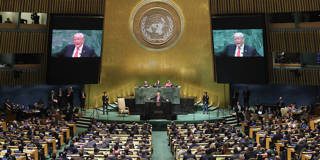World order is a matter of degree: it varies over time, depending on technological, political, social, and ideological factors that can affect the global distribution of power and influence norms. It can be radically altered both by broader historical trends and by a single major power's blunders.
CAMBRIDGE – After the Berlin Wall came down in 1989, and almost a year before the Soviet Union collapsed in late 1991, US President George H.W. Bush proclaimed a “new world order.” Now, just two months into Donald Trump’s second presidency, Kaja Kallas, the European Union’s top diplomat, has declared that “the international order is undergoing changes of a magnitude not seen since 1945.” But what is “world order,” and how is it maintained or disrupted?

CAMBRIDGE – After the Berlin Wall came down in 1989, and almost a year before the Soviet Union collapsed in late 1991, US President George H.W. Bush proclaimed a “new world order.” Now, just two months into Donald Trump’s second presidency, Kaja Kallas, the European Union’s top diplomat, has declared that “the international order is undergoing changes of a magnitude not seen since 1945.” But what is “world order,” and how is it maintained or disrupted?